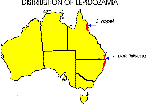
Range map for species of Lepidozamia (Jones 1993). You can also create a highly detailed map, and access specimen data, using the "search" function at the Australia Virtual Herbarium.

L. peroffskyana produces one of the largest of all cycad cones, rivaled only by Encephalartos transvenosus (Jones 1993) [C.J. Earle, 1996.03.11].

Lepidozamia
von Regel
Common names
Taxonomic notes
There are two extant species:
There are also two extinct species from the Tertiary of Australia. Described 1857 based on a living plant (L. peroffskyana) in the St. Petersburg Botanical Garden (Jones 1993). A systematic study was done by Johnson (1959).
Description
Large plants with a stout, erect trunk. Notable features include:
- leaflet bases inserted on the upper midline of the rachis;
- an emergent cylindrical trunk clothed with persistent leaf bases;
- an absence of suckers and offsets;
- young parts covered with short hairs;
- alternate flushes of leaves and cataphylls;
- petioles and rachises lacking spines and prickles;
- leaflets without a midrib and decurrent at the base;
- lower leaflets not spine-like;
- cones sessile or nearly so;
- male cones opening in a prominent spiral at maturity;
- sporophylls non-peltate, shortly hairy on the outer surface, lacking spines, appendages or ornamentation; and
- outer face of female sporophylls prominently deflexed (Jones 1993).
Distribution and Ecology
Australia: New South Wales and Queensland, near the coast, in rainforest or similarly sheltered forest sites. Soils are well-structured loams (Jones 1993).
Remarkable Specimens
L. hopei achieves heights of 20 m and diameters of 50 cm. It is the tallest of cycads (Jones 1993).
Ethnobotany
Both species are popular ornamentals suitable, when young, for indoor container plantings. The leaves are used for decoration (Jones 1993). Aboriginal use for food is not cited but seems likely in view of the size and local abundance of these plants.
Observations
Have seen both species in native habitat. Both are easily located; see species descriptions for details.
Remarks
First known from Eocene sediments in New South Wales. Propagation is solely from seed, which takes 12 to 24 months to germinate (Jones 1993).
Citations
Johnson, L.A.S. 1959. The families of cycads and the Zamiaceae of Australia. Proceedings of the Linnean Society of New South Wales 84:64-117.
See also
The World List of Cycads.

